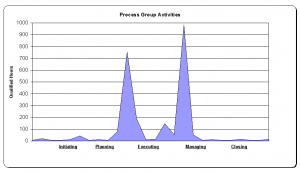 The Program Management Body of Knowledge (PMBOK) would have you Identify Stakeholders at the crossroads of the Initiating process group and the Communications knowledge area. Basically, what the Project Management Institute (PMI) is trying to say is you should be identifying all of the people who are somehow related to the project. Who holds a stake in the success or failure of your project? You should complete this activiy at the beginning of your project lifecycle.
This isn't bad advise. It doesn't matter if you're a Project Management Professional (PMP) or an Agile practitioner. The idea here is to lower the risk of having someone, who may be for or against your project, from disrupting things. You have to accept that everyone has different and unique motivations. Know your sponsor, product owner, stakeholders...zombies. Zombies!? Of course. Once you identify everyone even remotely associated with your project, try to understand their motivations so you will be able to build relationships. But look out for the zombies. They won't listen to you and just do what they want. Don't pass judgement on them. Zombies are zombies. They're going to do whatever they want and you and everyone else is just going to have to deal with it.
The Program Management Body of Knowledge (PMBOK) would have you Identify Stakeholders at the crossroads of the Initiating process group and the Communications knowledge area. Basically, what the Project Management Institute (PMI) is trying to say is you should be identifying all of the people who are somehow related to the project. Who holds a stake in the success or failure of your project? You should complete this activiy at the beginning of your project lifecycle.
This isn't bad advise. It doesn't matter if you're a Project Management Professional (PMP) or an Agile practitioner. The idea here is to lower the risk of having someone, who may be for or against your project, from disrupting things. You have to accept that everyone has different and unique motivations. Know your sponsor, product owner, stakeholders...zombies. Zombies!? Of course. Once you identify everyone even remotely associated with your project, try to understand their motivations so you will be able to build relationships. But look out for the zombies. They won't listen to you and just do what they want. Don't pass judgement on them. Zombies are zombies. They're going to do whatever they want and you and everyone else is just going to have to deal with it.
Today I was in a meeting with a zombie. Everyone in the meeting appeared to have the same opinion of the topic at hand. Everyone, that is, but the zombie. The topic itself really isn't important. But it was basically a room of people against one zombie. You may start to ask yourself what the zombie must be thinking. Seriously, it's an exercise in futility. Just make sure you know who they are early on and make some contingency plans.
So, remember kids, identify stakeholders (and zombies) early in your project. Start building relationships with the people. Find out what motivates them. Know who are the zombies! Take appropriate action, either by buying large quantities of plywood to board up doors and windows to the office or get some brain flavored mints. If you can't keep the zombie away, the least you can do is freshen their breath.
Like the image? Find it at Pictofigo

